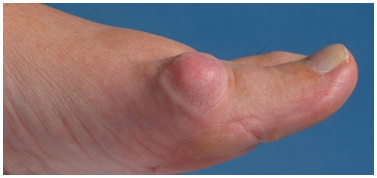Information
When arthritis affects the big toe, the joint can become painful, stiff and bulky. This is known as hallux rigidus. Pain is usually worse with activity, such as walking, but it can also be painful at rest. Sometimes a bump forms on the top of the joint (dorsal bunion). If the bump is large, it can rub on footwear and the skin can become reddened, inflamed and swollen (see photograph below). With arthritis of the big toe, the toe usually remains straight (unlike a “bunion” where the toe is at an angle).

Non surgical treatments:
Painkillers (paracetamol/NSAIDs) and changing footwear to extra width or special footwear possibly with a cushion-pad or in-shoe foot support. A robust shoe with a firm sole generally helps with big toe joint pain whereas a flimsy sole will make pain worse. Avoid high heels and shoes with a narrow toe.
A podiatrist can help with hallux rigidus symptoms and issue pads/insoles/orthoses which can improve foot posture and pain in the joint. Sometimes an injection of corticosteroid will help in the early stages of the disease. Patients can self refer to a NHS podiatrist or seek care privately.
Indications for surgery
Surgery may be needed if the above measures have been tried and failed. The decision to go ahead with surgery is usually made based on the following symptoms:
- Pain is considerable
- There is significant disruption to your lifestyle or activities
- The bump is painful and worsening
Referral for surgery is needed only for pain and is not performed for cosmetic purposes.
The options for surgery
There are three main surgical options:
- Joint fusion (the joint is made solid)
- Cheilectomy (the joint is “cleaned up” and bone is trimmed from the joint)
- Implants (metal or plastic implants are used to keep the bones separated).
Aims of hallux rigidus surgery
- To reduce pain and deformity
- To remove bumps that form around the joint
- Make footwear more comfortable
- To improve foot function
- To improve general mobility.
M.A. & J. McK. 24-09-24
Who can refer:
GPs
Who to refer:
Criteria for referral for surgery:
- The deformity is painful and worsening
- Difficulty obtaining suitable shoes
- There is significant disruption to lifestyle or activities
- Referral for hallux rigidus surgery is needed only for pain and is not performed for cosmetic purposes.
Who not to refer:
- Cosmetic reasons
- H/o Peripheral arterial disease
- Patients who do not want to consider surgery.
How to refer:
SCI gateway (Lauriston Buildings > Orthopaedics – Foot and Ankle)
Minimal Referral Details:
- Patient has been seen by podiatry
- Length of time since symptoms started
- Non-operative management tried.
Non surgical treatments:
Painkillers (paracetamol/NSAIDs) and changing footwear to extra width or special footwear possibly with a cushion-pad or in-shoe foot support. A robust shoe with a firm sole generally helps with big toe joint pain whereas a flimsy sole will make pain worse. Avoid high heels and shoes with a narrow toe.
A podiatrist can help with hallux rigidus symptoms and issue pads/insoles/orthoses which can improve foot posture and pain in the joint. Sometimes an injection of corticosteroid will help in the early stages of the disease. Patients can self refer to a NHS podiatrist or seek care privately.
Big Toe Cheilectomy Surgery: https://edinburghorthopaedics.org/media/hi1nhyy3/big-toe-joint-cheilectomy-v2-0.pdf
Fusion of the 1st MTP Joint: https://edinburghorthopaedics.org/media/hkdjsdye/fusion-of-the-big-toe-1st-mtp-joint-v2-0_patient-info-approved.pdf













